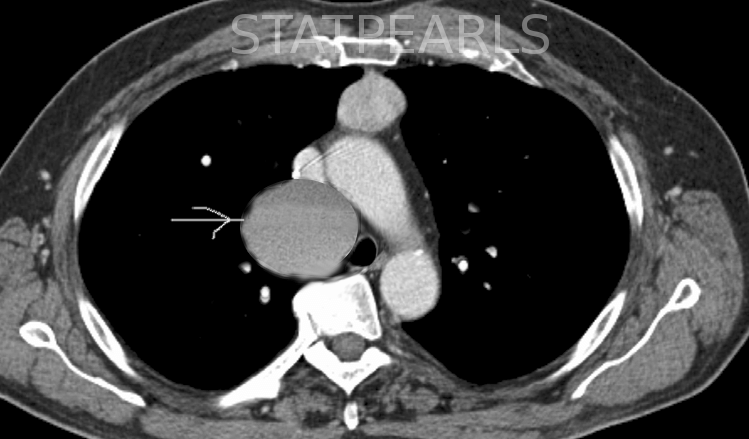[1]
Reichelt O, Grieser T, Wunderlich H, Möller A, Schubert J. Bronchogenic cyst. A rare differential diagnosis of retroperitoneal tumors. Urologia internationalis. 2000:64(4):216-9
[PubMed PMID: 10895088]
[2]
Limaïem F, Ayadi-Kaddour A, Djilani H, Kilani T, El Mezni F. Pulmonary and mediastinal bronchogenic cysts: a clinicopathologic study of 33 cases. Lung. 2008 Jan-Feb:186(1):55-61
[PubMed PMID: 18064522]
Level 3 (low-level) evidence
[3]
McAdams HP, Kirejczyk WM, Rosado-de-Christenson ML, Matsumoto S. Bronchogenic cyst: imaging features with clinical and histopathologic correlation. Radiology. 2000 Nov:217(2):441-6
[PubMed PMID: 11058643]
[4]
St-Georges R, Deslauriers J, Duranceau A, Vaillancourt R, Deschamps C, Beauchamp G, Pagé A, Brisson J. Clinical spectrum of bronchogenic cysts of the mediastinum and lung in the adult. The Annals of thoracic surgery. 1991 Jul:52(1):6-13
[PubMed PMID: 2069465]
[5]
Lardinois D, Gugger M, Ris HB. Bronchogenic cyst of the left lower lobe associated with severe hemoptysis. European journal of cardio-thoracic surgery : official journal of the European Association for Cardio-thoracic Surgery. 1999 Sep:16(3):382-3
[PubMed PMID: 10554866]
[6]
Aktoğu S, Yuncu G, Halilçolar H, Ermete S, Buduneli T. Bronchogenic cysts: clinicopathological presentation and treatment. The European respiratory journal. 1996 Oct:9(10):2017-21
[PubMed PMID: 8902460]
[7]
Mawatari T, Itoh T, Hachiro Y, Harada H, Kobayashi T, Saitoh T, Ohsawa H, Watanabe A, Abe T. Large bronchial cyst causing compression of the left atrium. Annals of thoracic and cardiovascular surgery : official journal of the Association of Thoracic and Cardiovascular Surgeons of Asia. 2003 Aug:9(4):261-3
[PubMed PMID: 13129426]
[8]
Cohn JE, Rethy K, Prasad R, Mae Pascasio J, Annunzio K, Zwillenberg S. Pediatric Bronchogenic Cysts: A Case Series of Six Patients Highlighting Diagnosis and Management. Journal of investigative surgery : the official journal of the Academy of Surgical Research. 2020 Jul:33(6):568-573. doi: 10.1080/08941939.2018.1527419. Epub 2018 Nov 15
[PubMed PMID: 30430886]
Level 2 (mid-level) evidence
[9]
Bolton JW, Shahian DM. Asymptomatic bronchogenic cysts: what is the best management? The Annals of thoracic surgery. 1992 Jun:53(6):1134-7
[PubMed PMID: 1596146]
[10]
Lee DH, Park CK, Kum DY, Kim JB, Hwang I. Clinical characteristics and management of intrathoracic bronchogenic cysts: a single center experience. The Korean journal of thoracic and cardiovascular surgery. 2011 Aug:44(4):279-84. doi: 10.5090/kjtcs.2011.44.4.279. Epub 2011 Aug 18
[PubMed PMID: 22263169]
[11]
Patel SR, Meeker DP, Biscotti CV, Kirby TJ, Rice TW. Presentation and management of bronchogenic cysts in the adult. Chest. 1994 Jul:106(1):79-85
[PubMed PMID: 8020324]
[12]
Ribet ME, Copin MC, Gosselin B. Bronchogenic cysts of the mediastinum. The Journal of thoracic and cardiovascular surgery. 1995 May:109(5):1003-10
[PubMed PMID: 7739231]
[13]
Chen TJ, Liao CH, Shen TC. Bronchogenic cyst. QJM : monthly journal of the Association of Physicians. 2018 Dec 1:111(12):905. doi: 10.1093/qjmed/hcy140. Epub
[PubMed PMID: 29939368]
[14]
Hasegawa T, Murayama F, Endo S, Sohara Y. Recurrent bronchogenic cyst 15 years after incomplete excision. Interactive cardiovascular and thoracic surgery. 2003 Dec:2(4):685-7
[PubMed PMID: 17670158]
[15]
Gharagozloo F, Dausmann MJ, McReynolds SD, Sanderson DR, Helmers RA. Recurrent bronchogenic pseudocyst 24 years after incomplete excision. Report of a case. Chest. 1995 Sep:108(3):880-3
[PubMed PMID: 7656652]
Level 3 (low-level) evidence
[16]
Makhija Z, Moir CR, Allen MS, Cassivi SD, Deschamps C, Nichols FC 3rd, Wigle DA, Shen KR. Surgical management of congenital cystic lung malformations in older patients. The Annals of thoracic surgery. 2011 May:91(5):1568-73; discussion 1573. doi: 10.1016/j.athoracsur.2011.01.080. Epub 2011 Mar 21
[PubMed PMID: 21420068]
[17]
Rice DC,Putnam JB Jr, Recurrent bronchogenic cyst causing recurrent laryngeal nerve palsy. European journal of cardio-thoracic surgery : official journal of the European Association for Cardio-thoracic Surgery. 2002 Mar;
[PubMed PMID: 11888786]
[18]
Rammohan G, Berger HW, Lajam F, Buhain WJ. Superior vena cava syndrome caused by bronchogenic cyst. Chest. 1975 Oct:68(4):599-601
[PubMed PMID: 1175425]
[19]
Worsnop CJ, Teichtahl H, Clarke CP. Bronchogenic cyst: a cause of pulmonary artery obstruction and breathlessness. The Annals of thoracic surgery. 1993 May:55(5):1254-5
[PubMed PMID: 8494445]
[20]
Di Lorenzo M, Collin PP, Vaillancourt R, Duranceau A. Bronchogenic cysts. Journal of pediatric surgery. 1989 Oct:24(10):988-91
[PubMed PMID: 2809973]
[21]
Zaugg M, Kaplan V, Widmer U, Baumann PC, Russi EW. Fatal air embolism in an airplane passenger with a giant intrapulmonary bronchogenic cyst. American journal of respiratory and critical care medicine. 1998 May:157(5 Pt 1):1686-9
[PubMed PMID: 9603155]
[22]
Endo C, Imai T, Nakagawa H, Ebina A, Kaimori M. Bronchioloalveolar carcinoma arising in a bronchogenic cyst. The Annals of thoracic surgery. 2000 Mar:69(3):933-5
[PubMed PMID: 10750790]
[23]
Kennebeck GA, Wong AK, Berry WR, Higgins JP, Manubens SM. Mediastinal bronchogenic cyst manifesting as a catastrophic myocardial infarction. The Annals of thoracic surgery. 1999 Jun:67(6):1789-91
[PubMed PMID: 10391298]

